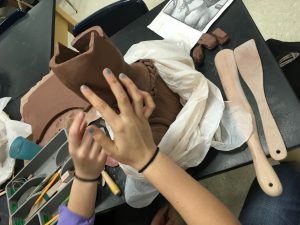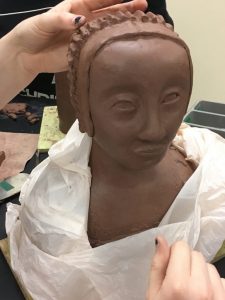This fall I saw an Amaco/Brent video series being shared on Facebook. It is an Amaco/ Brent sculpture lesson using a Renaissance painting as the basis for a three-dimensional form. The videos are only a few minutes each and use time-lapse photography to abbreviate the demonstration process.
I was inspired by a friend’s visit to London to create a file of portraits for the students to select their figure. At first, I thought that I would present this part as a research task however, I was concerned about having to veto their choices due to the complexity of the point of view, cropping and just having too many choices. Most of the images are from European artists, however, I did include some American works as well. Once the project was rolled out I was sharply aware that I did not do a good job including ethnic diversity;. I am collecting images now, (please share your ideas and recommendations).

Austin works on the proportion of the lower face on his portrait based on Grant Wood’s “American Gothic.”

Rietta S grade 11 working on a portrait based on the work of Sandro Botticelli.
Throughout the first semester, students worked independently completing projects with different methods of construction and intentions. The portrait bust project has brought cohesion to the group as they have worked on this challenge. It has provided many opportunities for students to collaborate and help each other solve problems. Examples include how to cut slabs to create the curving transition from the neck to the head, pushing in eye sockets to create the bridge of the nose, and complementing each other’s accomplishments.

Morgan helping Mary work out the placement of the eyes on her portrait based on the work of Sandro Botticelli.
These pieces are built like vessels, hollow and from the bottom up. The shape and size of the initial slab base influence the size and proportion of the over all form. It provides an opportunity to observe details of clothing, jewelry, and hairstyles from another era while trying to recreate or summarize them with clay. The students are using red earthenware clay and will make their own choices in how to finish the surface of their sculpture.

Penny applies details to Anne Boleyn’s head covering.